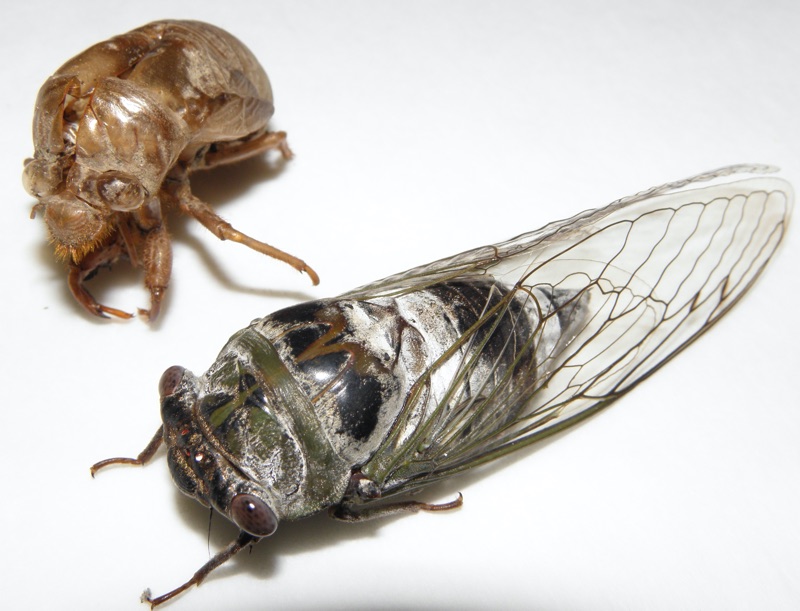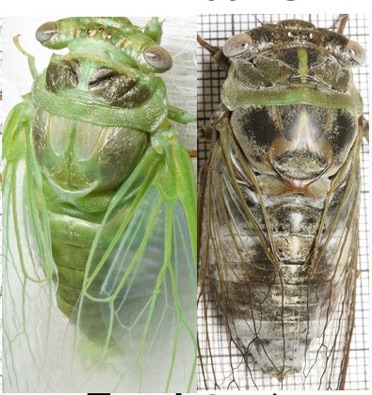Megatibicen grossus (Fabricius, 1775) aka Northern Dusk Singing Cicada. It’s the biggest cicada in North America!
FYI, the name of this cicada is changing to Megatibicen grossus (Fabricius, 1775). See: Sanborn, A.F. (2023) Resolving taxonomic issues of cicadas (Hemiptera: Cicadidae) including new combinations, new synonymies, and revised status, with updates on the diversity of the Brazilian cicada fauna and new records for four South American countries. Zootaxa, VOL. 5318 NO. 3: 20 JUL. 2023, 339-362. DOI: 10.11646/ZOOTAXA.5318.3.2

See all Megatibicen auletes photos and information on cicadamania.com (there is a lot)!
Song type: Call
Source: ©Insect Singers | Species: M. auletes
Video
Video Playlist
Playlists contain multiple videos found on YouTube.
Name, Location and Description
- Cicada Name: Megatibicen auletes (Germar, 1834)
- Short Name: M. grossus
- Common Name: Northern Dusk Singing Cicada
- Synonym/Former Name: Tibicen auletes, Megatibicen auletes
- When: July-September. Peaks in August.
- Where it is found: AL, AR, CT, DE, DC, FL, GA, IL, IN, IA, KS, KY, LA, MD, MA, MI, MS, MO, NE, NJ, NY, NC, OH, OK, PA, SC, TN, TX, VA, WV, WI
- Maps: Biogeography of the Cicadas (Hemiptera: Cicadidae) of North America, North of Mexico [PDF]
- Description: The largest North American cicada. Olive green to rusty brown with black, tan and white coloring. Heavy white pruinosis. M on mesonotum typically partially ocluded by pruinosis. Sings at dusk.
- Eye Color: gray / beige
- Pronotal Collar Color: olive or rusty brown
- Identification: Bug Guide
- Identification: iNaturalist
- Identification: Bill Reynolds on iNaturalist
- Subject Matter Expert website: Cicada Central
- Image: Insect Images
- Taxonomic Information: Integrated Taxonomic Information System
- Song: Insect Singers
Song and morphological descriptions by Wm. T. Davis from MISSISSIPPI CICADAS, WITH A KEY TO THE SPECIES OF THE SOUTHEASTERN UNITED STATES1
Its song is monotonous in tone and not loud, considering the size
of the insect. It often commences to sing late in the afternoon and continues off and on until dark.
A. Large, heavy bodied species ; head broad, uncus simple, and first cross vein in the fore wings starting from radius 3 far back, or about one third distant from base of first marginal cell.
BB. Uncus broad at the base, triangular in shape and generally about as broad as long. Opercula broad and rounded at the extremities; no definite black area on the central part of the abdomen beneath, usually unicolorus.
EE. Wings broad, hind margin of the pronotum or collar green or greenish and more than 2 mm. broad.
F. Anal cells or membranes at base of fore and hind wings gray. Dorsal segments of the abdomen not margined with brown ; in fresh specimens the basal segments pruinose, also the terminal segments, leaving the four middle segments black. A large species expanding over 110 mm.
A comparison of teneral (soft) and sclerotized (hard) M. auletes
Classification:
Family: Cicadidae
Subfamily: Cicadinae
Tribe: Cryptotympanini
Subtribe: Cryptotympanina
Genus: Megatibicen
Species: Megatibicen auletes (Germar, 1834)
List of sources
- Davis, W.T. 1919. MISSISSIPPI CICADAS, WITH A KEY TO THE SPECIES OF THE SOUTHEASTERN UNITED STATES. Journal of the New York Entomological Society, Vol. XXVI, Nos. 3-4. Read on archive.org
- Full Binomial Names: ITIS.gov
- Common names: BugGuide.net; The Songs of Insects by Lang Elliott and Wil Herschberger; personal memory.
- Locations: Biogeography of the Cicadas (Hemiptera: Cicadidae) of North America, North of Mexico by Allen F. Sanborn and Polly K. Phillips.
- Descriptions, Colors: personal observations from specimens or photos from many sources. Descriptions are not perfect, but may be helpful.
Notes:
- Some descriptions are based on aged specimens which have lost some or a lot of their color.

7 replies on “Megatibicen grossus aka Northern Dusk Singing Cicada formerly Megatibicen auletes”
Awesome, we just found one of these guys at our house by our porch light. Scared the living daylights out of us at first, because he was stuck under the awning and squacking like crazy.
I personally love cicadas and want to collect them while my poor husband is not quite so excited about them, but I’m so glad I got to see this guy in all his glory when we finally calmed down!
I have this cicada that I found and I am going to pin it! So excited 🙂
This is the one cicada I am most interested in hearing. I personally never heard it before, coming from Lancaster County, NE.
We love cicadas, they are the coolest. We seem to have a lot of this species in South Carolina, they seem to get whiter as they get older, and are almost covered in white when they finally die. Is this right?
We’ve found 4-5 dead ones, mostly eaten by ants. Found a huge live one yesterday. Thanks so much for the info on this site. My kids and I were able to identify the species and we loved listening to the song. Now we know the sound we hear all the time is the cicada!
I like cicadas
And I have a cicada
Awesome!